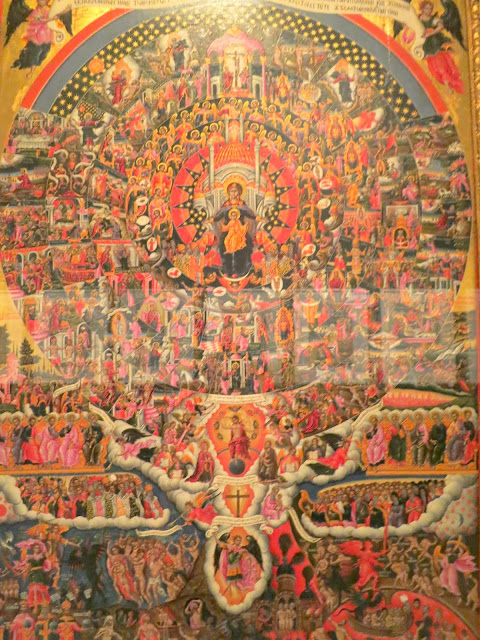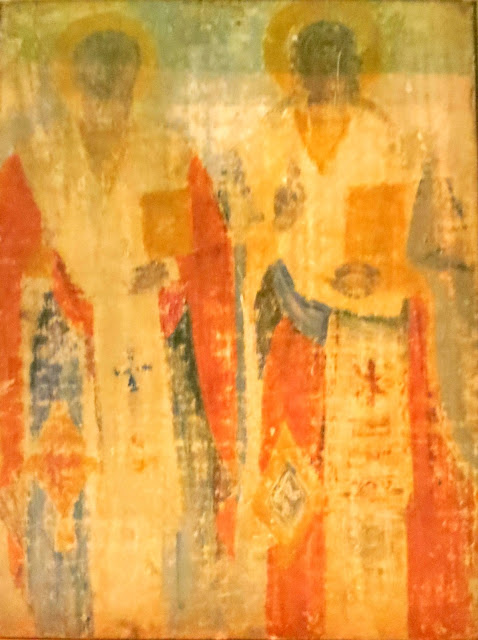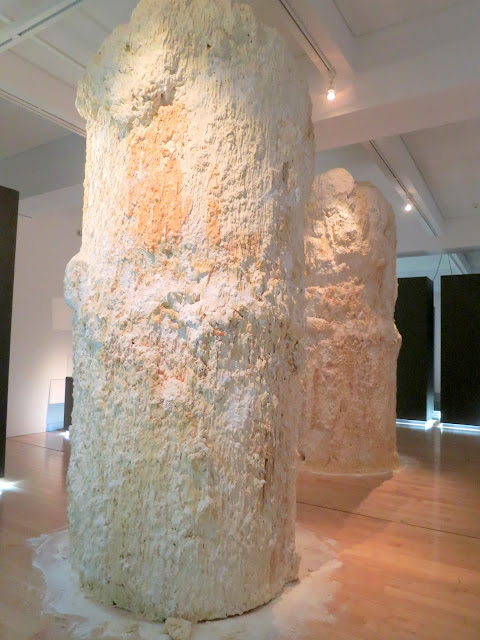Ametpia
at the Benaki Museum, Pireos, Athens.
The search for meaning is always part of viewing an exhibition: what does this work of art mean? What was the artist's intention? What does it mean to me? Can I make sense of it?
All these questions were swiftly abandoned once we entered the labyrinth of Ametpia.
(floor plan and list of exhibits)
There was no write-up next to the artworks, not even numbers to help us connect what was in front of us with the names of the artists in the catalogue. It would have taken hours to make the connection between the physical labyrinth that we were inhabiting and the catalogue. So, we abandoned any attempts to do so, and instead just walked, wandered and tried to absorb the cornucopia of what we were experiencing. It was a true experience of the senses. All senses. We had entered the labyrinth of the absurd, the bizarre, the stuff of dreams. The world of Hieronymus Bosch, it felt at times. So we just experienced.
This is how the curators introduce the exhibition (I must point out here that the English translations at the Benaki are poor. I have written to them about this, but did not get a satisfactory answer):
'Ametpia is the privilege of disproportion, of excess, the rejection of an overall vision, the error that turns out to be right. Out of the meeting of the Benaki Museum and the DESTE Foundation, works and objects become proofs of an impulse that, as a precise and determinate entity, takes part in the evolution of thought.
Totally uninterested in the values of community life, which promotes the virtues of measure and the happy mean, dismeasure is the expression of an original purposeless drive, which chooses neither to have nor not to have and whose sole intention is to be exercised without reserve. The degree of dismeasure is dependent on just how radical is the drive that expresses it.
When a drive that dominates the field of consciousness finds a particular form, it becomes instigation, stirring opposition or prompting imitation. If the imitation overcomes by impulse the inclination to restraint, an epidemic phenomenon occurs that forces the community to change its way of thinking and behaviour and its common action. An order of dismeasure can be extended to the point of becoming a conventional value, triggering a series of effects from the social environment to the natural person'.
This is just a small (!) selection of what we experienced while wandering around the vast gallery space.
The entrance to the exhibition
the first part was a series of maps
some old, some new
we wound our way through - some of the paths were very narrow
and then suddenly we would come upon a much wider passage, like a clearing
we then came upon a section of extremely intricate prints
looking closer
and again

we were warned that some people may find some of the images provocative

looking closer - a clear reference to Matisse


In this section the exhibits look like embroidery but they are not. They do however, anticipate the next section which is embroidery
Classic Greek embroidery, the kind we learnt to do at school and which I continued making for years afterwards
referencing Greek icons
the juxtapositions were quite bizarre
an altered Greek icon of the Virgin Mary
Gold leaf referencing the Greek Orthodox icon that hangs on the opposite wall

Kolokotronis was one of the heroes of the Greek struggle for independence from the Turks
Unification or Death recalling Eleutheria i Thanatos (Freedom or Death) the main slogan of the Greek freedom fighters during Greece's struggle of independence from the Turks
the slogan is reflected in the mirror of this installation
we turned to yet another path of the maze and came upon these two huge columns - there was an overpowering sweet smell here
these are made entirely of white chocolate with some caramel for binding
This obese torso with its rolls of fat is also part of this section
as is this - the section of excess
My photographs do not do this section justice: this statue
and this photograph

are both reflected in the mirror. We then rounded the corner and found a door - went in to a small dark space that contained some kind of hairy creature (it was too dark to see properly) and then we realised that the mirror was a one way mirror so that we could look into this space
and then we moved on to a series of photographs
note the stake in his heart
John the Baptist amongst all the suffering
and then some bizarre figures
including this one
that has cigarette butts as feet
and a cob webb for a stomach
one of the extremely narrow passages where we could glimpse the print of a face but could not get near it as the passage was too narrow - so, just a tease
and we made it to the end. What an experience!
One of the aims of the curators is 'to promote new and radical developments in contemporary art practice and inspire novel curatorial approaches' - they have certainly achieved that.































































Wow. Quite some surreal experience that must have been. But also stimulating in a strange way.
ReplyDeleteOlga, we left the gallery with huge grins on our faces, saying 'wasn't that something?' It really was an experience.
Delete